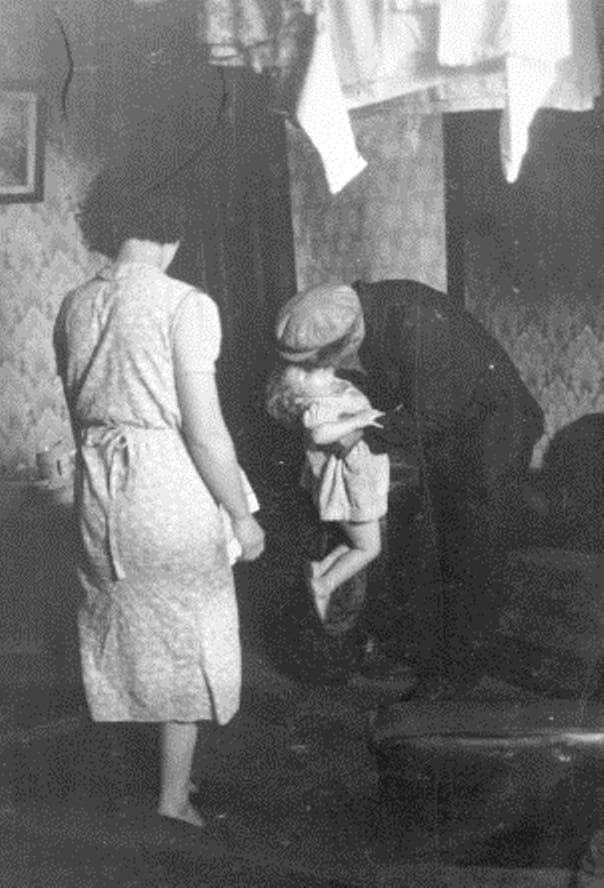Bert Hardy
Life in the Elephant - Father Kissing Child, 1948
Vintage Gelatin Silver Print
19.21 x 13.34 cms
7 9/16 x 5 4/16 ins
Series: 1. Life in the Elephant (1948)
10442
Provenance
The Estate of A. L. Lloyd, Picture Post journalist.Stephen Daiter Gallery, Chicago
Picture Post stamp verso Its voice has the rasp of trams, trains, trucks. Its eyes have the blaze of street-stalls, eel-stands, pin-table arcades and chestnut cans. Its anatomy is decked...
Picture Post stamp verso
Its voice has the rasp of trams, trains, trucks. Its eyes have the blaze of street-stalls, eel-stands, pin-table arcades and chestnut cans. Its anatomy is decked with sooty bricks, cast iron spikes and the marble pillars of pubs. Its heart is that of its people - kind as a housewife, rough as a worker, busy as a tradesman, wide as a wide-boy. (A. L. Lloyd, 'Life in the Elephant', Picture Post, 8 January 1949, vol.42, no.2, p.10)
Bert Hardy gained fame as the chief photographer for Picture Post, the most important photograph-led news magazine of the 1940s and 1950s. He traveled widely, capturing the leading events and personalities of the day, as well as gaining acclaim for his pictures of deprived areas of Britain, including an award-winning series of photographs of life in London's Elephant and Castle district.
These photographs were taken over a three week period, between 18 November and 8 December 1948 for a picture story entitled 'Life in the Elephant', which appeared in Picture Post on 8 January 1949. The Hyman Collection includes both published and unpublished works from the series.
The wintry weather had much to do with the atmosphere in these photographs. As a result there is an almost Dickensian quality to some of these scenes. A dense haze of smog shrouds the carts, trams and buses and the streets teem with a lively mixture of different characters.
An entrée into this world was provided by Maisie, a prostitute who appears in some of Hardy's photographs of Elephant and Castle. She introduced Hardy to many of those he photographed, allowing him an insight into domestic life as well as life on the streets.
Against a backdrop of bomb and building sites, Hardy captures unchanging patterns of life - street markets, coal deliveries, horse dealers - as well as providing glimpses of the modern city, such as some of London's first traffic lights. Bursting with incident, these photographs range from intimate domestic interiors to convivial pub scenes, moving from bustling streets filled with people, buses and trams to scenes of children playing hide and seek amidst the rubble of a bomb or building site.
Its voice has the rasp of trams, trains, trucks. Its eyes have the blaze of street-stalls, eel-stands, pin-table arcades and chestnut cans. Its anatomy is decked with sooty bricks, cast iron spikes and the marble pillars of pubs. Its heart is that of its people - kind as a housewife, rough as a worker, busy as a tradesman, wide as a wide-boy. (A. L. Lloyd, 'Life in the Elephant', Picture Post, 8 January 1949, vol.42, no.2, p.10)
Bert Hardy gained fame as the chief photographer for Picture Post, the most important photograph-led news magazine of the 1940s and 1950s. He traveled widely, capturing the leading events and personalities of the day, as well as gaining acclaim for his pictures of deprived areas of Britain, including an award-winning series of photographs of life in London's Elephant and Castle district.
These photographs were taken over a three week period, between 18 November and 8 December 1948 for a picture story entitled 'Life in the Elephant', which appeared in Picture Post on 8 January 1949. The Hyman Collection includes both published and unpublished works from the series.
The wintry weather had much to do with the atmosphere in these photographs. As a result there is an almost Dickensian quality to some of these scenes. A dense haze of smog shrouds the carts, trams and buses and the streets teem with a lively mixture of different characters.
An entrée into this world was provided by Maisie, a prostitute who appears in some of Hardy's photographs of Elephant and Castle. She introduced Hardy to many of those he photographed, allowing him an insight into domestic life as well as life on the streets.
Against a backdrop of bomb and building sites, Hardy captures unchanging patterns of life - street markets, coal deliveries, horse dealers - as well as providing glimpses of the modern city, such as some of London's first traffic lights. Bursting with incident, these photographs range from intimate domestic interiors to convivial pub scenes, moving from bustling streets filled with people, buses and trams to scenes of children playing hide and seek amidst the rubble of a bomb or building site.





















